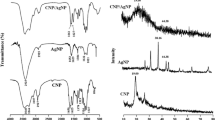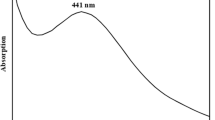Abstract
Mosquitoes are the major vectors of many diseases such as the malaria, filariasis, dengue, and Japanese encephalitis. Mosquitoes propagate quite successfully in a variety of aquatic habitats such as drinking water system, manmade water bodies, and sewage contaminated aquatic system. Since, water is essential for all life, without it, life won’t progress and at the same time, the quality of the water also important. With the unique structural features present in chitosan bio-polymer helps to bind effectively with fine suspended particles, pollutants, bacteria, heavy metals etc. The biocompatible and biodegradable nature of chitosan makes it a potential candidate for mosquito breeding water purification purposes. In this regard, chitosan has been extracted from freshwater crab shells Scylla serrata and reduced for silver nanoparticle synthesis. It has been utilized as a potent tool in control of young instars of Aedes aegypti and its breeding water purification. Bio-synthesized chitosan-reduced silver nanoparticles were characterized by UV–Vis spectrum, Fourier transform infrared spectroscopy (FTIR), scanning electron microscopy (SEM), energy-dispersive X-ray analysis (E-DAX), and X-ray diffraction (XRD). In laboratory condition, the chitosan silver nanocomplex was found to possess toxicity against young instars (I, II, III, and IV) of Aedes aegypti at the concentrations of 2, 4, 6, 8, and 10 ppm followed by chitosan treatment alone. The surface stagnant water from dengue vector breeding site checked the water purification parameters, such as water temperature (WT), pH, salinity, dissolved oxygen (DO), total dissolved solids (TDS), and electrical conductivity (EC) by using “μP Based Water & Soil Analysis Kit” (Model 1160). Further, from the results it is clearly postulated that the biomolecules present in the chitosan not only showed biopesticidal activity against mosquito larvae and pupae but also nullified the contaminants in the water and made human usage.
Access this chapter
Tax calculation will be finalised at checkout
Purchases are for personal use only
Similar content being viewed by others
References
Alsabagh, A. M., Fathy, M., & Morsi, R. E. (2015). Preparation and characterization of chitosan/silver nanoparticle/copper nanoparticle/carbon nanotube multifunctional nano-composite for water treatment: Heavy metals removal; kinetics, isotherms and competitive studies. RSC Advances, 69(5), 55774–55783.
Anitha, J., Murugan, K., Panneerselvam, C., Madhiyazhagan, P., Dinesh, D., Vadivalagan, C., Aziz, A. T., Chandramohan, B., Suresh, U., Rajaganesh, R., Subramaniam, J., Nicoletti, M., Higuchi, A., Alarfaj, A. A., Murugan, M. A., Kumar, S., & Benelli, G. (2016). Earthworm-mediated synthesis of silver nanoparticles: A potent tool against hepatocellular carcinoma, Plasmodium falciparum parasites and malaria mosquitoes. Parasitology International, 65, 276–284.
Benelli, G. (2015). Plant-borne ovicides in the fight against mosquito vectors of medical and veterinary importance: A systematic review. Parasitology Research, 114, 3201–3212.
Benelli, G. (2016). Plant-mediated biosynthesis of nanoparticles as an emerging tool against mosquitoes of medical and veterinary importance: A review. Parasitology Research, 115, 23–34.
Benelli, G., Pavela, R., Iannarelli, R., Petrelli, R., Cappellacci, L., Cianfaglione, K., Afshar, F. H., Nicoletti, M., Canale, A., & Maggi, F. (2017a). Synergized mixtures of Apiaceae essential oils and related plant-borne compounds: Larvicidal effectiveness on the filariasis vector Culex quinquefasciatus Say. Industrial Crops and Products, 96, 186–195.
Benelli, G., Pavela, R., Maggi, F., Petrelli, R., & Nicoletti, M. (2017b). Commentary: Making green pesticides greener? The potential of plant products for nanosynthesis and pest control. Journal of Cluster Science, 28, 3–10.
Benelli, G., Rajeswary, M., & Govindarajan, M. (2017c). Towards green oviposition deterrents? Effectiveness of Syzygium lanceolatum (Myrtaceae) essential oil against six mosquito vectors and impact on four aquatic biological control agents. Environmental Science and Pollution Research International, 25(11), 10218–10227.
Crini, G. (2005). recent developments in polysaccharide-based materials used as adsorbents in wastewater treatment. Progress in Polymer Science, 30, 38–70.
Dananjaya, S. H., Godahewa, G. I., Jayasooriya, R. G., Chulhong, O. H., Lee, J., & Zoysa, M. D. (2014). Chitosan silver nanocomposites (CAgNCs) as potential antibacterial agent to control Vibrio Tapetis, 5(5).
Diaz, A., Rincon, N., Escorihuela, A., Fernandez, N., Chacin, E., & Forster, C. F. (1999). A preliminary evaluation of turbidity removal by natural coagulants indigenous to Venezuela. Process Biochemistry, 35, 391–395.
Finney, D. J. (1971). Probit analysis. Cambridge University, London 68–78.
Hamidi, M., Azadim, A., & Rafiei, P. (2008). Hydrogel nanoparticles in drug delivery. Advanced Drug Delivery Reviews, 60, 638–1649.
Huang, M. (2004). Uptake and cytotoxicity of chitosan molecules and nanoparticles: Effects of molecular weight and degree of deacetylation. Pharmaceutical Research, 21(2), 344–353.
Lamarque, G. (2005). Physicochemical behavior of homogeneous series of acetylated chitosans in aqueous solution: Role of various structural parameters. Biomacromolecules, 6(1), 131–142.
Lertsutthiwong, P., How, N. C., Chandrkrachang, S., & Stevens, W. F. (2002). Effect of chemical treatment on the characteristics of Shrimp Chitosan. Journal of Metals, Materials and Minerals., 12(1), 11–18.
Marimuthu, S., Rahuman, A. A., Govindasamy, R., Thirunavukkarasu, S., Arivarasan, V. K., Chidambaram, J., Asokan, B., Zahir, A. A., Elango, G., & Chinnaperumal, K. (2011). Evaluation of green synthesized silver nanoparticles against parasites. Parasitology Research, 108, 1541–2154.
Murugan, K., Anitha, J., Dinesh, D., Suresh, U., Rajaganesh, R., Chandramohan, B., Subramaniam, J., Paulpandi, M., Vadivalagan, C., Amuthavalli, P., Wang, L., Hwang, J. S., Wei, H., Alsalhi, M. S., Devanesan, S., Kumar, S., Pugazhendy, K., Higuchi, A., Nicoletti, M., & Benelli, G. (2016). Fabrication of nano-mosquito codes using chitosan from crab shells: Impact on non-target organisms in the aquatic environment. Ecotoxicology and Environmental Safety, 132, 318–328.
Murugan, K., Dinesh, D., Paulpandi, M., Subramaniam, J., Rakesh, R., Amuthavalli, P., Panneerselvam, C., Suresh, U., Vadivalagan, C., Alsalhi, M. S., & Devanesan, S. (2017a). Mangrove helps: Sonneratia alba-synthesized silver nanoparticles magnify guppy fish predation against Aedes aegypti young instars and down-regulate the expression of envelope (E) gene in dengue virus (serotype DEN-2). Journal of Cluster Science, 28(1), 437–461.
Murugan, K., Jaganathan, A., Suresh, U., Rajaganesh, R., Jayasanthini, S., Higuchi, A., Kumar, S., & Benelli, G. (2017b). Towards bio-encapsulation of chitosan-silver nanocomplex? Impact on malaria mosquito vectors, human breast adenocarcinoma cells (MCF-7) and behavioral traits of non-target fishes. Journal of Cluster Science, 28(1), 529–550.
Muzzarelli, R. A. A., & Rochetti, R. (1985). Determination of the degree of deacetylation of chitosan by first derivative ultraviolet spectrophotometry. Journal of Carbohydrate Polymers, 5, 461–472.
Nareshkumar, A., Murugan, K., Madhiyazhagan, P., Kovendan, K., Prasannakumar, K., & Thangamani, S. (2011). Mosquitocidal and water purification properties of Cynodon dactylon, Aloe vera, Hemidesmus indicus and Coleus amboinicus leaf extracts against the mosquito vectors. Parasitology Research, 110, 1435–1443.
Pontius, F. W. (2016). Chitosan as a drinking water treatment coagulant. American Journal of Civil Engineering., 4(5), 205–215.
Qin, C., Li, H., Xiao, Q., Liu, Y., Zhu, J., & Du, Y. (2006). Water solubility of chitosan and its antimicrobial activity. Carbohydrate Polymers., 63, 367–374.
Rajesh, P., & Mahadik, N. (2017). Chitosan mediated nanoparticles from Saccharomyces cerevisiae and its Mosquito larvicidal activity. Journal of Applied and Advanced Research, 2(3), 179–183.
Usha, C., & Rachel, D. G. A. (2014). Biogenic synthesis of silver nanoparticles by Acacia nilotica and their antibacterial activity. International Journal of Scientific Research, 3, 27–29.
Varma, A. J., Deshpande, S. V., & Kennedy, J. F. (2004). Metal complexation by chitosan and its derivatives. Carbohydrate Polymers, 55, 77–93.
Ward, M., & Benelli, G. (2017). Avian and simian malaria: Do they have a cancer connection. Parasitology Research, 116(3), 839–845.
World Health Statistics. (2017). Monitoring health for the SDGs.
Zeng, D., Wu, J., & Kennedy, J. F. (2008). Application of chitosan flocculant to water treatment. Carbohydrate Polymers, 71(1), 135–139.
Acknowledgements
Dr. J. Anitha is grateful to the University Grant Commission (New Delhi, India), Project No. PDFSS-2014-15-SC-TAM-10125.
Conflicts of Interest
The authors declare no conflicts of interest.
Informed Consent
Informed consent was obtained from all individual participants included in the study.
Author information
Authors and Affiliations
Editor information
Editors and Affiliations
Rights and permissions
Copyright information
© 2021 The Author(s), under exclusive license to Springer Nature Switzerland AG
About this paper
Cite this paper
Murugan, K. et al. (2021). Use of Bio-fabricated Silver Nanocomposite Capped with Mud Crab Shell (Scylla serrata) Chitosan for Water Purifications and Sustainable Management of Mosquito Vectors at Stagnant Water System in the Semiarid Zone of Tamil Nadu, India. In: Al-Maktoumi, A., et al. Water Resources in Arid Lands: Management and Sustainability. Advances in Science, Technology & Innovation. Springer, Cham. https://doi.org/10.1007/978-3-030-67028-3_16
Download citation
DOI: https://doi.org/10.1007/978-3-030-67028-3_16
Published:
Publisher Name: Springer, Cham
Print ISBN: 978-3-030-67027-6
Online ISBN: 978-3-030-67028-3
eBook Packages: Earth and Environmental ScienceEarth and Environmental Science (R0)




